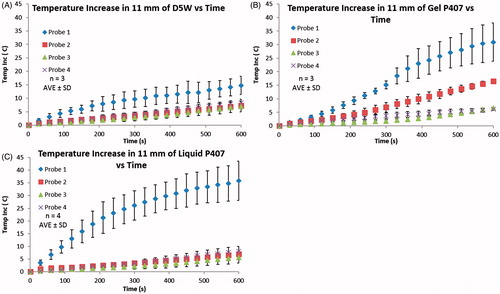Figures & data
Figure 1. Set-up for fluid heating rate testing: 230 mL of hydrodissection fluid was placed within a plastic container and subjected to MW ablation for 15 or 20 min for D5W and P407, respectively. (A) Top view. Temperature probes were placed 1.65 cm apart from one another and the ablation probe, creating two concentric rings (inner and outer). (B) Side view. Steel tubes were used to maintain temperature probe locations within the fluid. The ablation probe, steel tubes and temperature probes were inserted 7, 5 and 5.5 cm into the fluid, respectively. Temperature readings were obtained every second.
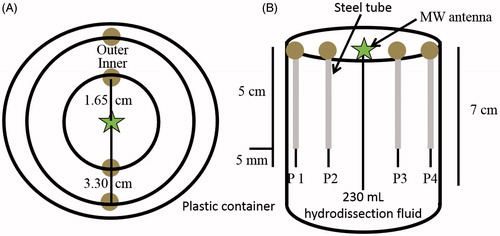
Figure 2. (A) Set-up for ex vivo ablation experiments in a plastic container. Two bovine liver pieces are held at a constant distance, d = 11 mm, by two plastic gates. This separation enables the establishment of a hydrodissection fluid barrier. The ablation probe was placed 1 cm away from the hydrodissection fluid. Temperature probes 1–4 were organized in this fashion to examine convective versus conductive heat dissipation within the hydrodissection barrier; temperature readings were obtained every second. (B) Plastic gate construction. A rectangular opening was cut from the middle of a piece of plastic. Screen mesh was secured over the opening using plastic screws. The mesh-covered opening allowed for direct heat transfer from the neighbouring liver pieces to the hydrodissection fluid while maintaining a constant hydrodissection distance.

Figure 3. (A and B) Temperature versus time for MW ablation in 230 mL of D5W and P407, respectively, using the set-up depicted in . The probe temperatures within D5W were very similar during the entire experiment due to convective heat dissipation, resulting in a rate of temperature change of 3.4 ± 0.9 °C/min. Similarly, the liquid P407 (8 °C) exhibited similar probe temperatures until the P407 started to micellise (at ∼23 °C) and gel (at 32 °C) where a significant difference in temperatures was seen. To further examine the P407 data, dT/dt were calculated and plotted in C and D, showing the rates of temperature change for probes 2 and 3, and probes 1 and 4, respectively. The rate of temperature change for probes 2 and 3 increased drastically as the P407 started to micellise and gel. As a gel the P407 cannot convectively dissipate heat to the outer locations, probes 1 and 4 experienced a decrease and plateau in rate of temperature change. Once the P407 gel melted (at ∼54 °C) convective heat dissipation again became dominant and resulted in the large rate of temperature change experienced for probes 1 and 4. This shows that the P407 gel primarily dissipates heat through conduction, whereas D5W and liquid P407 are convection dominated.
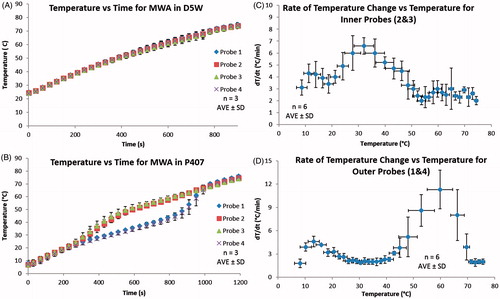
Figure 4. Freeze frame images to visualise heat dissipation. Top row: convection in D5W manipulates the blue dye allowing for visualisation of the convection cell. This contrasts with the control (middle row) where the blue dye sinks and only dissipates via diffusion in D5W. 0’ designates the time point immediately after administration of one blue dye drop. Bottom row: conduction in a layered P407 gel yields a green sphere that increases radially from the active portion of the microwave antenna.
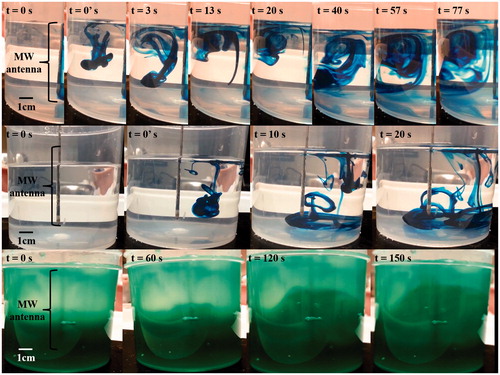
Figure 5. (A) 11 mm of D5W, (B) 11 mm of gel P407, and (C) 11 mm of liquid P407. A Cool-Tip RF ablation machine was used to perform RF ablation on liver pieces depicted in the experimental set-up in . Ablations were performed for 10 min and temperatures at the corresponding locations were obtained every second. Temperature readings at every 30 s are plotted. Gel P407 had the highest probe 1 temperature and difference between probes 2–4, while D5W and liquid P407 had lower probe 1 temperatures and more similar values for probes 2–4. These results are due to D5W and liquid P407 being able to convectively dissipate heat from probe 1 throughout the bulk of the fluid, whereas the gel P407 is unable to convectively transfer heat to the periphery.
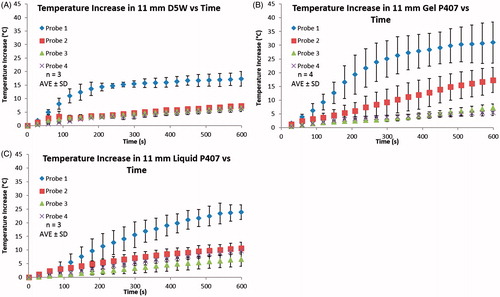
Table 1. Temperature measurements within the hydrodissection barrier after ex vivo RF and microwave using bovine liver. Probe locations as per .
Figure 6. (A) 11 mm of D5W, (B) 11 mm of gel P407, and (C) 11 mm of liquid P407. A Neuwave MW ablation machine was used to perform MW ablation on liver pieces depicted in the experimental set-up in . Ablations were performed for 10 min and temperatures at the corresponding locations were obtained every second. Temperature readings at every 30 s are plotted. Gel P407 had the highest temperature difference between probes 2–4 while D5W and liquid P407 have more similar values for probes 2–4. Again, these results are due to D5W and liquid P407 being able to convectively dissipate heat from probe 1 throughout the bulk of the fluid, whereas the gel P407 is unable to convectively dissipate heat. Here liquid P407 behaves like the gel P407 at probe 1 (because this location is a gel) while the liquid P407 behaves like D5W at probes 2–4.
